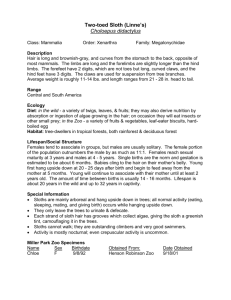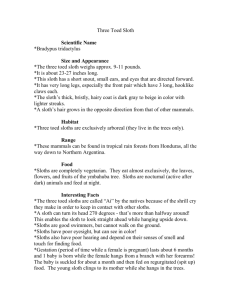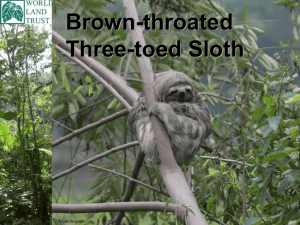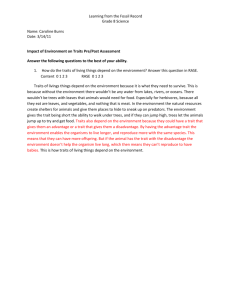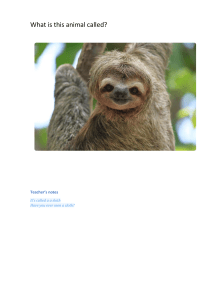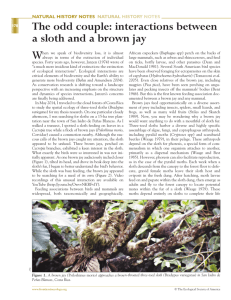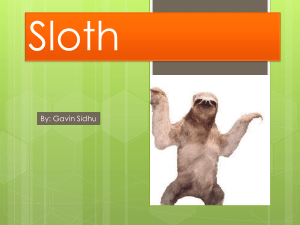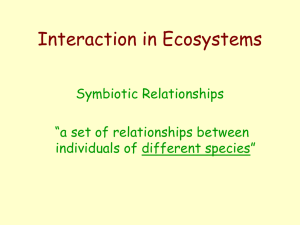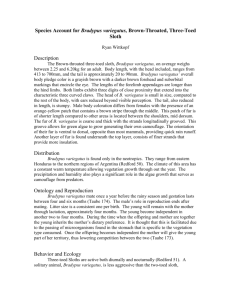ppt
advertisement
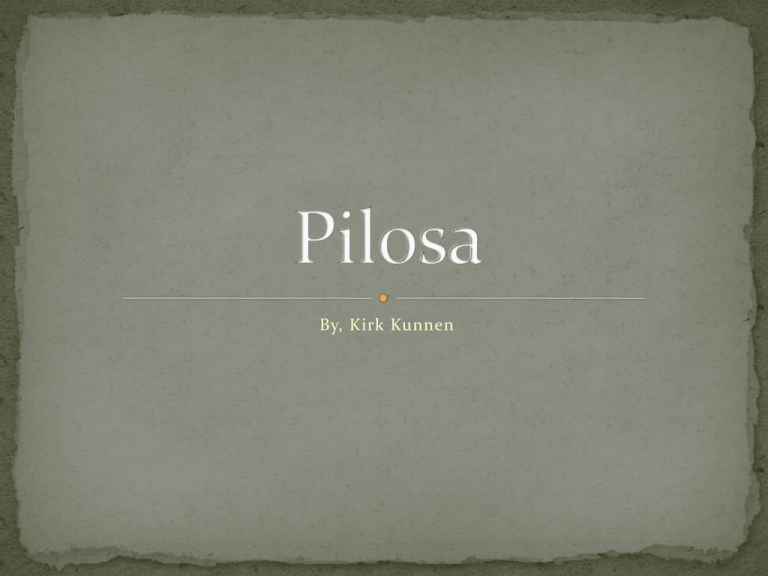
By, Kirk Kunnen Pilosa Facts Pilosa in Latin means hairy Contains anteaters and sloths Found only in the Americas today Central and South America Origins are unclear but can be traced back to South America in the early Tertiary • Cyclopediae • Silky Anteater • Myrmecophagidae • Giant Anteater • Northern Tamandua • Southern Tamandua / Specialized to eat ants and termites Jaws Became longer snouts Teeth have been reduced Tongues have became longer Spine covered Very strong forelimbs and claws For digging up termite nest and ant hills Opening up tree bark Can be used in defense against jaguars (Giant anteater) Walk on knuckles with claws curved under http://animal.discovery.com/search/results.html?focus=video&query=anteaters&search Adaptive Radiation • Suborder Folivora • Bradypodidae • Pygmy Three-toed sloth • Brown-throated Three-toed sloth • Pale-throated Three-toed sloth • Maned Three-toed sloth Megalonychidae • Hoffman’s Two-toed sloth • Southern Two-toed sloth Megatheriidae megatheriid ground sloths Mylodontidae Myylodontid ground sloths Orophodontidae orophodontid ground sloths Scelidotheriidae Scelidotheriid ground sloths Long curved claws used to hang from branches Slow moving Specialized in eating leaves Canine teeth have receded Now have ever growing peg-like molars Tree dwelling Hang upside down Can swim and move about on the ground if they have to Fur on their stomach curves to the back to shed rain http://www.youtube.com/watch?v=ndMKTnSRsKM Field Metabolic Rate, Water Flux, and Food Consumption in Three-Toed Sloths (Bradypus variegatus) Kenneth Nagy and Gene Montgomery Study covered Field energy metabolism Water fluxes Efficiency of food consumption Barro Colorado Island, Panama Canal Zone Background Have a resting metabolic rate less than half that of a typical placental mammal Move slowly Muscles and nerves function more slowly than typical mammals The effect of these traits influence there net energetic cost and attendant food requirements Methods Used doubly labeled water to estimate field energy metabolism and water flux The decline in hydrogen isotope in a doubly labeled animal is water flux The washout rates of the isotopes in a measure of CO2 production (metabolic rate) Food Consumption Fecal and stomach samples were taken Analyzed for manganese concentration and energy content in order to estimate dry matter and energy assimilation Results Water influx and efflux where nearly equal Metabolic rates where highest in males and least in nonreproductive females but the difference was not significant Diet provides 10.4 metabolizable kJ (g dry food)^-1 Findings Energy Metabolism Aspects that contribute to low energy requirements Low and variable body temperature Behavioral thermoregulation Large portion of body mass as metabolically inactive material Heat-conserving rete mirabile in blood vessels in limbs Slow acting muscle and nerve fibers Water fluxes Approximate water balance Gets all of it’s water requirement from young and old leaves Energy assimilation Assimilation efficiency depends on the mix of leaves in the gut Adaptations for specific foods Anteaters Forelimbs and Claws Snout and Tongue Sloth Live in trees Move slow Have a common ancestor to armadillos Sloth Digestion and metabolism Traits that require low energy requirments Slow metabolism http://www.mammalsrus.com/eutheria/pilosa/pilosa.html Nagy, Kenneth A., and G. Gene Montgomery. "Field Metabolic Rate, Water Flux, and Food Consumption in ThreeToed Sloths (Bradypus Variegatus)." Journal of Mammalogy 61.3 (1980): 465-72. Print. Pictures http://www.blurtit.com/q7510327.html http://bushwarriors.wordpress.com/2010/10/06/iucn-species-of-the-day-silky-anteater/ http://www.houstonzooblogs.org/zoo/tag/houston/page/3 http://www.anteaters.com/tamanduas/ http://www.oum.ox.ac.uk/thezone/animals/life/eat5.htm http://www.thefullwiki.org/Evidence_of_common_descent http://www.learnanimals.com/pale-throated-three-toed-sloth/ http://animalnewsoftheworld.blogspot.com/ http://www.edgeofexistence.org/mammals/species_info.php?id=63 http://www.naturfoto-cz.de/brown-throated-three-toed-sloth:bradypus-variegatus-photo-1308.html http://www.junglewalk.com/info/mammals-information.htm http://www.theanimalfiles.com/mammals/anteaters_relatives/linnaeuss_two_toed_sloth.html http://www.flickr.com/photos/seabird/3076501058/ http://www.coloring-pictures.net/drawings/IceAge/Sid-ground-sloth.php http://www.flickr.com/photos/jewing/2540054220/ http://www.nhc.ed.ac.uk/index.php?page=493.500.503
